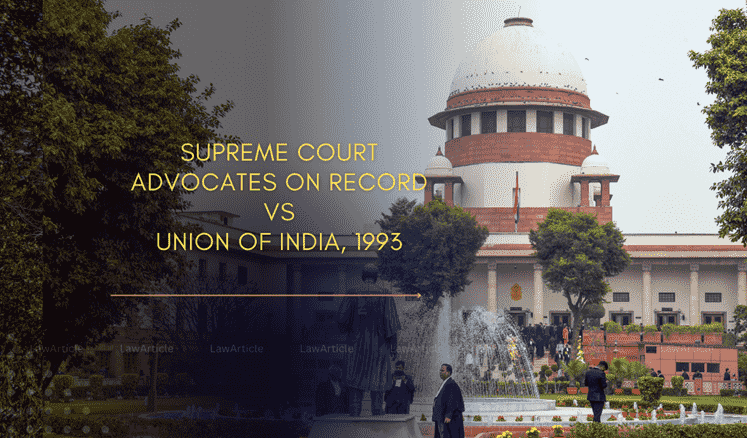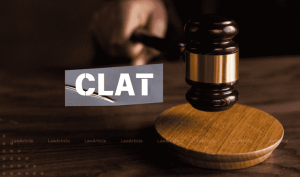Supreme Court Advocates on Record Vs. UOI, 1993
Supreme Court Advocates on Record Vs. UOI 1993 EQUIVALENT CITATION: (2016) 5 SCC 1, (2016) 2 SCC (LS) 253 BENCH: Justice Jagdish Singh Khehar, Justice Chelameswar, Justice Madan B. Lokur, Justice Kurian Joseph, Justice Adarsh Kumar Goel PETITIONER: Supreme Court Advocates on Record Association RESPONDENT: Union of India DATE OF JUDGEMENT: 06/10/1993
BRIEF
The case Supreme Court Advocates on Record Vs. UOI (1993) is a significant landmark in Indian legal history. Here are the details of the case The case primarily dealt with the issue of judicial appointments and the role of the judiciary in the appointment of judges to the Supreme Court and High Courts of India. The petitioners, the Advocates-on-Record Association, raised concerns about the executive’s influence in judicial appointments, arguing that it undermined the independence of the judiciary, which is crucial for upholding the rule of law. The case questioned whether the judiciary should have a more dominant role in the appointment process to ensure an impartial and fair selection of judges. The constitutional validity of Articles 124 and 217, which deal with the appointment of judges to the Supreme Court and High Courts, respectively, was also challenged on grounds that they needed reforms to ensure a transparent and unbiased selection process.
FACTS
The case Supreme Court Advocates on Record Vs. UOI (1993) involved a challenge to the existing system of judicial appointments in India. Here are the detailed facts of the case In India, the appointment of judges to the Supreme Court and High Courts is governed by Articles 124 and 217 of the Constitution, respectively. Historically, the process involved significant involvement of the executive (President of India) in consultation with the Chief Justice of India and other senior judges. In its judgment, the Supreme Court emphasized the need for a more transparent and accountable system of judicial appointments. It laid down principles to ensure that appointments to the judiciary are made based on merit and integrity, free from any undue influence. The court directed the government to initiate reforms in the appointment process, suggesting measures to enhance transparency and objectivity. This included the establishment of a collegium system where senior judges of the Supreme Court would play a pivotal role in recommending candidates for judicial appointments.
ISSUES
The case “Supreme Court Advocates-on-Record Association vs Union of India” (1993) is a landmark case in Indian constitutional law, primarily dealing with issues related to judicial appointments, specifically the procedure for appointment of judges to the Supreme Court and High Courts. The case arose out of concerns regarding the independence of the judiciary and the process of judicial appointments in India. Before this case, judicial appointments were primarily made by the Executive (President of India), in consultation with the Chief Justice of India and other judges.
1. Independence of Judiciary: The main issue was whether the Executive’s primacy in judicial appointments compromised the independence of the judiciary. The court emphasized the importance of maintaining an independent judiciary as a cornerstone of democracy.
2. Collegium System: The Supreme Court, through its interpretation of Articles 124 and 217 of the Constitution, introduced the Collegium system. Under the Collegium system, the judiciary (Chief Justice of India and a forum of senior judges) gained significant primacy in the process of judicial appointments. The Collegium system involves recommendations for appointments and transfers of judges by the Chief Justice of India and a collegial body of senior judges.
3. Judicial Review: The case reinforced the doctrine of judicial review, asserting the Supreme Court’s authority to interpret the Constitution and ensure the separation of powers between the judiciary and the executive.
Subsequent Developments: –
The judgment laid the foundation for subsequent cases and discussions on judicial reforms in India. It led to debates on the transparency of judicial appointments and the need for a balanced approach between judicial independence and accountability. In essence, the “Advocates-on-Record Association” case of 1993 remains a pivotal moment in Indian legal history, shaping the dynamics of judicial appointments and reinforcing the judiciary’s role as an independent and powerful branch of government.
JUDGEMENT
The judgment in the case “Supreme Court Advocates-on-Record Association vs Union of India” (1993) fundamentally addressed the process of judicial appointments in India, emphasizing the independence of the judiciary and establishing the Collegium system. Here are the key points from the judgment:
1. Independence of Judiciary: The Supreme Court underscored the importance of judicial independence as a fundamental aspect of the Constitution’s framework. It ruled that judicial appointments should not be solely controlled by the Executive to prevent any potential influence over the judiciary.
2. Collegium System: The judgment introduced and institutionalized the Collegium system for judicial appointments. Under this system, the Chief Justice of India and a forum of senior judges of the Supreme Court gained primacy in recommending appointments and transfers of judges to the Supreme Court and High Courts.
3. Interpretation of Constitutional Provisions: The Court interpreted Articles 124 and 217 of the Constitution to emphasize that the judiciary should have a significant say in appointments, ensuring that only individuals of high integrity and competence are appointed as judges.
4. Judicial Review: The case reinforced the doctrine of judicial review, affirming the Supreme Court’s authority to interpret the Constitution and strike down any law or action that violates its provisions, particularly those relating to judicial independence.
5. Impact on Executive Authority: The judgment curtailed the Executive’s traditional authority in judicial appointments, marking a significant shift towards a more independent judiciary with greater control over its own composition. the judgment in the “Advocates-on-Record Association” case of 1993 transformed the landscape of judicial appointments in India, establishing the Collegium system that continues to be a subject of debate and reform efforts to balance judicial independence with transparency and accountability.
ANALYSIS of Supreme Court Advocates on Record Vs. UOI, 1993
The case of “Supreme Court Advocates-on-Record Association vs Union of India” (1993) is pivotal in Indian legal history, primarily focusing on judicial appointments and the independence of the judiciary. Here’s a detailed analysis of its significance
- Pre-1993 Scenario: Prior to this case, judicial appointments in India were largely controlled by the Executive (President of India), with limited judicial input.
- Concerns: There were concerns about political influence in judicial appointments, potentially compromising the impartiality and independence of the judiciary. The case underscored the critical importance of judicial independence as a foundational principle of democracy and rule of law. It highlighted the need to insulate judicial appointments from political pressures and external influences.
- Constitutional Interpretation: The Supreme Court interpreted Articles 124 and 217 of the Constitution, which deal with the appointment and transfer of judges of the Supreme Court and High Courts. It redefined the process of appointments to ensure greater judicial control and independence.
- Introduction of the Collegium System: The most significant outcome of the case was the establishment of the Collegium system. Under the Collegium system, the Chief Justice of India and a collegial body of senior judges recommend appointments and transfers of judges. This system aimed to enhance judicial independence by reducing Executive interference in judicial appointments.
- Impact on Executive Authority: The judgment curtailed the traditional dominance of the Executive in judicial appointments. It shifted the balance of power towards the judiciary, asserting its authority to safeguard its independence through internal mechanisms like the Collegium.
- Subsequent Developments and Criticisms: While the Collegium system aimed to ensure judicial independence, it has faced criticism over lack of transparency and accountability. Subsequent reforms and debates have sought to address these concerns while preserving the core principles of judicial independence.
Broader Implications:
Legal Precedent The case set a precedent for judicial review over matters related to judicial appointments, reinforcing the judiciary’s role as the guardian of the Constitution. Constitutional Evolution: It contributed to the evolving interpretation of the Constitution, particularly regarding the separation of powers and checks and balances. Public Confidence: The judgment aimed to enhance public confidence in the judiciary by ensuring that appointments are based on merit and integrity rather than political considerations. The “Advocates-on-Record Association” case of 1993 remains a landmark in Indian constitutional law, reshaping the process of judicial appointments and reinforcing the judiciary’s independence. It reflects the Supreme Court’s commitment to upholding constitutional values and maintaining the integrity of the judiciary as an independent pillar of democracy.
Also Read:
Rights of undertrial prisoners in India
How To Send A Legal Notice In India













